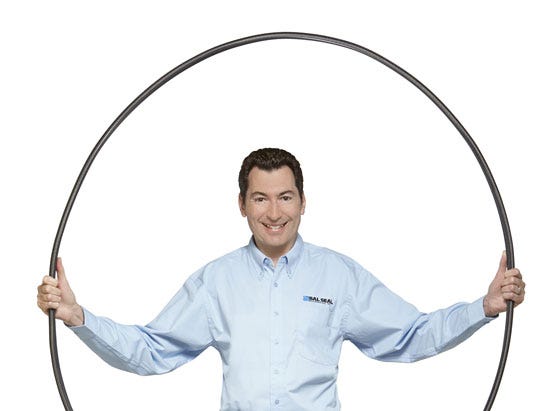How Hula Hoop-Sized Seals Make Imaging Systems More Reliable
March 10, 2015
A custom engineering company expands its line of spring-energized seals to include large diameter options for medical imaging systems.
Kristopher Sturgis
|
Bal-Seal offers seals for slow-speed rotary and reciprocating medical applications including MRI/CT scanners and for the doors/enclosures to autoclaves and sterilization equipment. |
Bal Seal Engineering Inc. has decided to expand its line of spring-energized seals to include large diameter (make that huge diameter, judging by the above image), low-friction seal options for slow-speed rotary and reciprocating medical applications. The new large-scale seals are intended to address the growing demand for high-performance sealing options in medical imaging systems across the board.
Bal Seal (Foothill Ranch, CA) specializes in custom-engineered sealing, connecting, conducting, and EMI shielding products, and believes the one-piece, large diameter seal offers equipment designers excellent resistance to wear, extrusion, and chemicals.
The low-friction, large diameter seals are available in a variety of FDA-compatible materials, and can be found in sizes up to 120 in. ID, while the thermoplastic seals are available in sizes up to 94 in. ID. Each seal has been energized with a Bal Seal canted coil spring, which is designed to promote even wear and prolong service life in imaging systems across the country.
"For large scanner arrays, the large diameter seals are typically used as environmental seals to prevent moisture and floating debris from entering the chamber," said Steve Twork, global marketing manager for Bal Seal Engineering. "The seals are designed to protect the equipment's electronics from being exposed to elements that can diminish the product life and service. While they don't directly impact image resolution, these seals do help maximize equipment uptime and reliability."
While there are many technologies springing up that could improve the technology behind medical imaging, there are still issues that need to be addressed to extend the life of these imaging and diagnostic machines to ensure reliability. Along with increasing the shelf life of these machines, ensuring they can operate efficiently when conditions such as temperature or humidity vary, is also crucial.
"These seals can be a viable option for any application requiring a seal up to 120 in. ID," Twork said. "They offer an excellent alternative to elastomer sealing because they provide superior resistance to wear, extrusion, and chemicals, as well as lower friction compared with rubber materials. New polymer blends are constantly being developed as well to meet pressure, temperature, and chemical compatibility requirements."
Company officials believe the large seals have potential when it comes to other medtech areas outside imaging.
"The large diameter seals can be used to seal the enclosures in large autoclaves and sterilization equipment," Twork said. "Helping to maintain a tight seal under high temperature and pressure changes."
Refresh your medical device industry knowledge at BIOMEDevice Boston, May 6-7, 2015. |
Kristopher Sturgis is a contributor to Qmed and MPMN.
Like what you're reading? Subscribe to our daily e-newsletter.
About the Author(s)
You May Also Like


